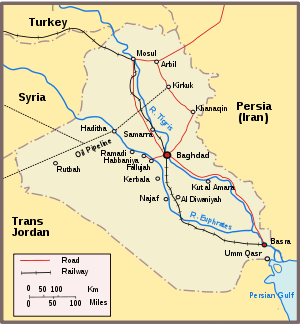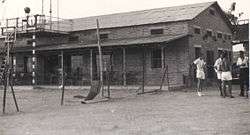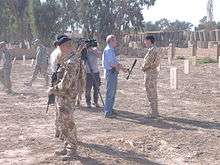RAF Habbaniya
Coordinates: 33°22′37.0″N 43°34′4.0″E / 33.376944°N 43.567778°E
| RAF Habbaniya | |
|---|---|
|
Station crest | |
| Active | 1936–1959 |
| Country | Iraq |
| Allegiance |
|
| Branch | Royal Air Force |
| Type | Flying station |
| Part of | British Forces in Iraq |
| Located near | Habbaniyah, Iraq |
| Royal Air Force Ensign |
 |
| March | Royal Air Force March Past |
| Commanders | |
| Notable commanders | Hughie Edwards (1956–58) |

Royal Air Force Station Habbaniya, more commonly known as RAF Habbaniya, (originally RAF Dhibban) was a Royal Air Force station at Habbaniyah, about 55 miles (89 km) west of Baghdad in modern-day Iraq, on the banks of the Euphrates near Lake Habbaniyah. It was operational from October 1936 until the 31 May 1959 when the British were finally withdrawn following the July 1958 Revolution.
It remained a major Iraqi military airbase.
History
RAF Habbaniya was constructed on the west bank of the Euphrates and opened on 19 October 1936. It was a British sovereign airbase which the British fought tooth and nail to protect it against the invading Iraqi Army in May 1941. RAF Habbaniya was also known as Second London with an entrance gate called London Gate. The squadrons, units and headquarters and the hospital gradually moved in from RAF Hinaidi, Baghdad, which was vacated by the British and renamed "Rashid Airfield" by the Iraqis. Originally called RAF Dhibban, the station was renamed RAF Habbaniya on 1 May 1938. The base was extensive and included the Air Headquarters of RAF Iraq Command, maintenance units, an aircraft depot, an RAF hospital, RAF Iraq Levies barracks, the RAF Armoured Car Company depot as well as fuel and bomb stores.
There were numerous billets, messes and a wide range of leisure facilities including swimming pools, cinemas and theatres, sports pitches, tennis courts and riding stables. It was self-contained with its own power station, water purification plant and sewage farm. Water taken from the Euphrates for the irrigation systems enabled green lawns, flower beds and even ornamental Botanical Gardens. After World War II the families of British personnel started living at Habbaniya and a school was started.
Within the camp perimeter was the Civil Cantonment which provided the accommodation for the families of the RAF Iraq Levies and the civilian workers and their families. The cantonment population of about 10,000 had their own schools, hospital, mosques, churches, temples, cinema and bazaars. Just outside the perimeter was the village of Humphreya in which more locally employed civilians and their families lived. It was the original construction camp for the company which constructed the base, Messrs Humphreys of Knightsbridge, London (and from which the name Humphreya arose).
There was a 7-mile perimeter fence round the base but this did not enclose the airfield which was outside. In 1952 a second airfield was built on the plateau to cope with the long range and jet aircraft using the base (this subsequently became the Iraqi Air Force Al Taqaddum airbase).

In the late 1930s Imperial Airways established a staging post on Lake Habbaniya for the flying boat service from the UK to British India using Short Empires. The lake provided the necessary landing area for these aircraft in the middle of the Mesopotamian desert.
The station was a large flying training school during World War II, as well as a transport staging airfield. During the Rashid Ali rebellion in 1941 the airfield was besieged by the Iraqi Army encamped on the overlooking plateau. On 2 May 1941, British forces from the airfield launched pre-emptive airstrikes on Iraqi forces throughout Iraq and the Anglo-Iraqi War began. The siege was lifted by the units based at Habbaniya, including pilots from the training school, a battalion of the King's Own Royal Regiment flown in at the last moment, Number 1 Armoured Car Company RAF and the RAF's Iraq Levies. The subsequent arrival of a relief column (Kingcol), part of Habforce sent from Palestine, then a British mandate, combined with the Habbaniya units to force the rebel forces to retreat to Baghdad.
Later in World War II Habbaniya became an important stage on the southern air route between the UK and the USSR. British Overseas Airways Corporation (BOAC) ran a regular passenger service via North Africa and the Middle East using Consolidated Liberator transports. The United States Army Air Forces Air Transport Command used Habbaniya as a stopover point between the large Lend-Lease aircraft assembly facility at Abadan Airport, Iran and Payne Field, Cairo. Also ATC operated a transport route from Habbaniya to Mehrabad Airport. Tehran. After World War II, BOAC discontinued the flying boat service and the hotel buildings at the lake were acquired by the RAF and used as a Rest and Recreation Centre.
Operational RAF squadrons were based at Habbaniya and very many aircraft passed through in transit.
Roald Dahl was stationed there in 1940, as described in his book, Going Solo, but his description is somewhat inaccurate and his opinion rather unfavourable compared with that of most personnel who served there.
Among the Units located at Habbaniya at various times were:
- No. 4 Service Flying Training School RAF;
- No. 115 Maintenance Unit RAF;[1]
- No. 134 Maintenance Unit RAF;
- 123 Signals Unit;
- 276 Signals Unit;
- Squadrons Nos 8, 30, 70, 84, 244, 249, 683;
- 19 Topographical Squadron R.E.
- No. 1 Armoured Car Company RAF;
- Number 2 Squadron RAF Regiment;
- 1st Battalion King's Own Royal Regiment.
- Iraq Levies, HQ, 1st, 2d,3d, 4th, and 5th Assyrian Levies and 8th Levy. All companies of 125 men plus their dependents totaling 2,000 people.
No. 8 Squadron RAF and No. 73 Squadron RAF were among the last flying squadrons to depart the base in the mid 1950s, along with No. 104 Maintenance Unit RAF and the RAF Hawker Hunter Servicing Flight/(Royal Iraqi Air Force) (the last active in 1957–1958).
The base closed on 31 May 1959 when the British were finally withdrawn following the July 1958 Revolution.
In June 1961 there were two Iraqi Air Force squadrons at the base:[2]
- No.1 Squadron, Venom FB.Mk.1, based at Habbaniyah AB, CO Capt. A.-Mun’em Ismaeel
- No.6 Squadron, Hunter, based at Habbaniyah AB, CO Capt. Hamid Shaban
Tom Cooper's book 'Arab MiG-19 and MiG-21 Units in Combat' describes Habbaniya as a base for Mikoyan-Gurevich MiG-21s by 1990.[3]
Current use
According to the Federation of American Scientists the site was used to produce Mustard gas (a chemical weapon). The site was built in 1983 – 1984. The factory produced the gas for use against the Iranians during the Iran–Iraq War. The factory produced 60–80 tonnes per year.[4]
After 2003, the former British airfield was used by both the United States Armed Forces and the New Iraqi Army as a forward operating base, and is now known as Camp Habbaniyah. From this outpost, combat operations are run from the outskirts of Fallujah to the outskirts of Ramadi. Since 2006 Camp Habbaniyah has grown into a Regional Training and Regional Support Center as well as the headquarters for the Iraqi Army 1st Division. On going Coalition and Iraqi construction projects have revitalized much of the base.
In December 2008, the U.S. Army and all civilian contractors, less twelve contractors from MPRI, departed Camp Habbaniyah. U.S. Marines had stayed behind to provide the Iraqi Army with additional perimeter security until a time TBD.
On 16 April 2009, a suicide-bomber dressed as an Iraqi 1st Lieutenant detonated a bomb among a group of Iraqi soldiers at a canteen.
As of 2015, Habbaniya serves as a base for Shia militias, the Iraqi army and its American trainers, in their ongoing campaign against ISIS.[5]
289 British and Commonwealth personnel, women, children and babies still lie buried in the RAF/Commonwealth War Graves Commission cemetery in Habbaniya. The register of those buried is held by the RAF Habbaniya Association. RAF Habbaniya Association

Units and aircraft
- No. 6 Squadron RAF (1950–1954) de Havilland Vampire FB5 & FB9
- No. 8 Squadron RAF (1956) de Havilland Vampire FB4
- No. 11 Squadron RAF (1941) Bristol Blenheim IV
- No. 14 Squadron RAF (1941) Bristol Blenheim IV
- No. 30 Squadron RAF (1938)
- No. 45 Squadron RAF (1941) Bristol Blenheim IV
- No. 52 Squadron RAF (1941–1942) Hawker Audax
- No. 55 Squadron RAF (1937–1939) Vickers Vincent Bristol Blenheim I
- No. 70 Squadron RAF (1937–1939) Vickers Valentia
- No. 73 Squadron RAF (1953–1955) de Havilland Vampire FB9 & FB1
- No. 74 Squadron RAF (1943) Hawker Hurricane I
- No. 82 Squadron RAF detachment (1951–1952) Avro Lancaster PR1
- No. 84 Squadron RAF (1941) Bristol Blenheim IV
- No. 94 Squadron RAF detachment (1941) Gloster Gladiator
- No. 123 Squadron RAF (1942) Gloster Gladiator
- No. 162 Squadron RAF (1942) Bristol Blenheim IV
- No. 185 Squadron RAF (1952–1952) de Havilland Vampire FB5
- No. 203 Squadron RAF detachment (1941) Bristol Blenheim IV
- No. 208 Squadron RAF detachment (1941) Hawker Audax
- No. 216 Squadron RAF detachment (1942) Lockheed Hudson IV
- No. 223 Squadron RAF detachment (1942) Martin Baltimore
- No. 244 Squadron RAF
- No. 249 Squadron RAF (1946) de Havilland Mosquito FB26 Hawker Tempest F6
- No. 261 Squadron RAF (1941) Gloster Gladiator Hawker Hurricane I
- No. 651 Squadron RAF detachment (1948) Auster AOP6
- No. 680 Squadron RAF detachment (1945–1946) Fairchild Argus
- No. 683 Squadron RAF (1952–1953) Vickers Valetta C1
- No. 1412 (Meteorological Flight) RAF (1942–1946) Gloster Gladiator Hawker Hurricane
- No. 1434 (Photo Survey) Flight RAF (1942) Bristol Blenheim
- No. 4 Flying Training School RAF (1939–1941)
- No. 104 Maintenance Unit RAF (1954–1956)
- No. 115 Maintenance Unit RAF (1945–1959)
- No. 134 Maintenance Unit RAF (1942 and 1943–1946)
See also
| Wikimedia Commons has media related to Royal Air Force. |
- List of former Royal Air Force stations
- Article 5 of the Anglo-Iraqi Treaty
- List of Royal Air Force Maintenance units
- Al Taqaddum
References
Notes
![]() This article incorporates public domain material from the Air Force Historical Research Agency website http://www.afhra.af.mil/.
This article incorporates public domain material from the Air Force Historical Research Agency website http://www.afhra.af.mil/.
- ↑ "RAF Habbaniya". Air of Authority – A History of RAF Organisation. Retrieved 10 June 2012.
- ↑ Tom Cooper Kuwait Emergency, Air Combat Information Group
- ↑ David Nicolle, Tom Cooper, Arab MiG-19 and MiG-21 Units in Combat, Volume 44 of Osprey Combat Aircraft, Osprey Publishing, 2004, ISBN 1841766550, 9781841766553, 78.
- ↑ https://fas.org/irp/gulf/cia/960517/60886_01.htm
- ↑ "The successful campaign provides a blueprint for future battles—with Fallujah and Mosul the next to come". The Economist. 28 December 2015. Retrieved 29 December 2015.
115 Maintenance Unit remained at RAF Habbaniya until 1959 (not 1954 as mentioned in the article). I was on the staff of 115 MU from 1957 to 1959.
Bibliography
- Dudgeon, Air Vice-Marshal A.G., CBE,DFC (Retd). Hidden Victory: The Battle of Habbaniya, May 1941. Stroud, Gloucestershire, UK: Tempus Publishing Ltd., 2001. ISBN 0-7524-2037-2.
- Jefford, Wing Commander C.G., MBE,BA,RAF (Retd). RAF Squadrons, a Comprehensive Record of the Movement and Equipment of all RAF Squadrons and their Antecedents since 1912. Shrewsbury, Shropshire, UK: Airlife Publishing, 2001. ISBN 1-84037-141-2.
- Sturtivant, Ray, ISO and John Hamlin. RAF Flying Training And Support Units since 1912. Tonbridge, Kent, UK: Air-Britain (Historians) Ltd., 2007. ISBN 0-85130-365-X.
Further reading
- Air Chief Marshal Sir David Lee (RAF officer), Flight from the Middle East: A History of the Royal Air Force in the Arabian Peninsula and Adjacent Territories 1945–1972 (London: Ministry of Defence: Air Historical Branch, RAF), 1984(?)
External links
- RAF Habbaniya Association
- "The Battle for Habbaniya, May 1941 – Diary of a pupil pilot, P/O Colin Dunford Wood, written at the time"
- "The Battle for Habbaniya, May 1941 – Intelligence reports"
